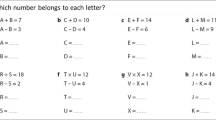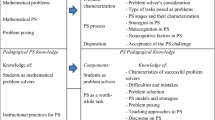Abstract
This study compared how selected mathematics textbooks from Mainland China and the United States at the lower secondary grade level represent various types of problems for classroom teaching and learning. The examination of problems was carried out based on the classifications of problem types established in the study, including routine problems versus non-routine problems, open-ended problems versus close-ended problems, traditional problems versus non-traditional problems, and application problems versus non-application problems, among others. Both the similarities and differences in the representation of problems in the selected textbooks were analyzed. The results were used to explore the possible influences of those textbooks on students’ different performances in mathematics, as revealed in cross-national comparisons. Discussions about how to improve the representation of problems in mathematics textbooks were provided at the end of the study.
Similar content being viewed by others
References
Bishop, A. (in press). A review of “How Chinese learn mathematics: Perspectives from insiders.” Asia-Pacific Journal of Education.
Brenner, M.E., Herman, S., Ho, H. & Zimmer, J.M. (1999). Cross-national comparison of representational competence. Journal for Research in Mathematics Education, 30(5), 541–557.
Cai, J. (1995). A cognitive analysis of U.S. and Chinese students’ mathematical performance on tasking involving computation, simple problem solving, and complex problem solving. Journal for Research in Mathematics Education (Monograph series 7). Reston, VA: National Council of Teachers of Mathematics.
Carpenter, T.P., Corbitt, M.K., Kepner, H.S. Jr., Lindquist, M.M. & Reys, R.E. (1980). Solving verbal problems: Results and implications from national assessment. Arithmetic Teacher, 28(1), 8–12.
Carter, J., Li, Y. & Ferrucci, B.J. (1997). A comparison of how textbooks present integer addition and subtraction in PRC and USA. The Mathematics Educator, 2(2), 197–209.
Days, H.C., Wheatley, G.H. & Kulm, G. (1979). Problem structure, cognitive level, and problem solving performance. Journal for Research in Mathematics Education, 10(2), 135–146.
Fan, L. (1999). Applications of arithmetic in US and Chinese textbooks: A comparative study. In G. Kaiser, E. Luna & I. Huntley (Eds.), Studies in mathematics education series: II. International comparisons in mathematics education (pp. 151–162). London: Falmer Press.
Fan, L. & Kaeley, G.S. (2000). The influence of textbooks on teaching strategies: An empirical study. Mid-Western Educational Researcher, 13(4), 2–9.
Fan, L. & Zhu, Y. (2000). Problem solving in Singaporean secondary mathematics textbooks. The Mathematics Educator, 5(1/2), 117–141.
Fan, L. & Zhu, Y. (2004). How have Chinese students performed in mathematics? A perspective from large-scale international mathematics comparisons. In L. Fan, N.Y. Wong, J. Cai & S. Li (Eds.), How Chinese learn mathematics: Perspectives from insiders, Vol. 1 (pp. 3–26). Singapore: World Scientific Publishers.
Goertz, M.E. (2000). Implementing standards-based reform: Challenges for state policy. In T. Duggan & M. Holmes (Eds.), Closing the gap: A report on the Wingspread conference: Beyond the standards horse race. Washington, DC: Council for Basic Education.
Graybeal, S.S. (1988). A study of instructional suggestions in fifth-grade mathematics and social studies teachers’ guides and textbooks. Doctoral dissertation, University of Chicago. (UMI: AAT T-30763).
Gu, L., Huang, R. & Marton, F. (2004). Teaching with variation: A Chinese way of promoting effective mathematics learning. In L. Fan, N.Y. Wong, J. Cai & S. Li (Eds.). How Chinese learn mathematics: Perspectives from insiders, Vol. 1 (pp. 309–347). Singapore: World Scientific Publishers.
Harding, D.C. (1995). A comparative study of German and American school mathematics textbooks in their approach to problem solving. Doctoral dissertation, University of New York. (UMI: AAT 9538085).
Hatfield, M., Edwards, N.T. & Bitter, G.G. (1997). Mathematics methods for elementary and middle school teachers, 3rd edn. Boston, MA: Allyn and Bacon.
Hembree, R. (1992). Experiments and relational studies in problem solving: A meta-analysis. Journal for Research in Mathematics Education, 23(3), 242–273.
Hiebert, J., Stigler, J., Jacobs, J., Givvin, K.B., Garnier, H., Smith, M., Hollingsworth, H., Manaster, A., Wearne, D. & Gallimore, R. (2005). Mathematics teaching in the United States today (and tomorrow): Results from the TIMSS 1999 video study. Educational Evaluation and Policy, 27(2), 111–132.
Holmes, E.E. (1995). New directions in elementary school mathematics. Englewood, NJ: Prentice-Hall.
Korithoski, T.P. (1988). Textbook usage and other content item taught in secondary mathematics methods courses. Doctoral dissertation, University of Montana. (UMI: AAT 8907414).
Li, Y. (1999). An analysis of algebra content, content organization and presentation, and to-be-solved problems in eighth-grade mathematics textbooks from Hong Kong, Mainland China, Singapore, and the United States. Doctoral dissertation, University of Pittsburgh. (UMI: AAT 9957757).
Love, E. & Pimm, D. (1996). ‘This is so’: A text on texts. In A.J. Bishop, K. Clements, C. Keitel, J. Kilpatrick & C. Laborde (Eds.), International handbooks of mathematics education (pp. 371–410). Dordrecht, Netherlands: Kluwer.
McConnell, J.W., Brown, S., Usiskin, Z., Senk, S.L, Widerski, T., Anderson, S., Eddins, S., Feldman, C.H., Flanders, J., Hackworth, M., Hirschhorn, D., Polonsky, L., Sachs, L. & Woodward, E. (1996). UCSMP algebra, 2nd edn. Glenview, IL: Scott Foresman.
Michael, N. (2002). Inside the PISA: Comparing two high achieving countries from the west (Finland) and from the east (Japan). Paper presented in the ICMI Comparative Study Conference 2002, Hong Kong, October, 2002.
Pace, A.J. (1986). The ability of third, fifth, and seventh graders to understand and apply a general problem-solving heuristic scheme. Paper presented at the Annual Meeting of the American Educational Research Association, San Francisco, CA, April, 1986. (ERIC Document Reproduction Service No. ED270221).
Patrick, J.J. (1993). Achievement of goal three of the six national education goals. ERIC Digest. (ERIC Document Reproduction Service No. ED360221)
Peak, L. (1996). Pursing excellence: A study of U.S. eighth grade mathematics and science teaching, learning, curriculum, and achievement in international context. Washington, DC: U.S. Department of Education.
Quintero, (1984). Children’s difficulties with two-step word problems. Paper presented at the Annual Meeting of the American Educational Research Association, New Orleans, LA, April, 1984. (ERIC Document Reproduction Service No. ED 242535).
Schmidt, W.H., McKnight, C.C., Valverde, G.A., Houang, R.T. & Wiley, D.E. (1997). Many visions, many aims: A cross-national investigation of curricular intentions in school mathematics. Boston: Kluwer Academic Publishers.
Siemon, D., Vitgona, J. & Cornielle, K. (2001). The middle year numeracy research projects: 5–9. Bundoora, VA: RMIT University.
Sosniak, L.A. & Stodolsky, S.S. (1993). Teachers and textbooks: Materials use in four fourth-grade classrooms. The Elementary School Journal, 93(3), 249–275.
Stanic, G. & Kilpatrick, J. (1988). Historical perspective on problem solving in the mathematics curriculum. In R. Charles & E. Silver (Eds.), The teaching and assessing of mathematical problem solving (pp. 1–22). Reston, VA: National Council of Teachers of Mathematics.
Stigler, J., Fuson, K., Ham, M. & Kim, M.S. (1986). An analysis of addition and subtraction word problems in American and Soviet elementary mathematics textbooks. Cognition and Instruction, 3(3), 153–171.
Stodolsky, S.S. (1989). Is teaching really by the book? In P.W. Jackson & S. Haroutunian-Gorden (Eds.), From Socrates to software: The teacher as text and the text as teacher: Eighty-eighth yearbook of the National Society for the Study of Education, Part I (pp. 159–184). Chicago, IL: National Society for the Study of Education.
Teh, K.S. & Looi, C.K. (1997). New Syllabus D Mathematics 1 (General editor: Lee, P.Y.), 4th edn. Singapore: Shing Lee Publishers.
U.S. Department of Education, Mathematics and Science Education Expert Panel (1999). Exemplary and promising mathematics programs. Washington, DC: Department of Education.
Usiskin, Z. & Dossey, J. (2004). Mathematics education in the United States 2004: A capsule summary fact book written for the Tenth International Congress on Mathematics Education (ICME-10), Copenhagen, Denmark. Reston, VA: National Council of Teachers of Mathematics.
Usiskin, Z., Flanders, J., Hynes, C., Polonsky, L., Porter, S. & Viktora, S. (1995). Transition Mathematics, 2nd edn. Glenview, IL: Scott Foresman.
Wong, N.Y., Lam, C.C. & Chan, C.S. (2002). The current state of the “lived space” of mathematics learning. Hiroshima Journal of Mathematics Education, 10, 27–52.
Yudin, L. & Kates, S.L. (1963). Concept attainment and adolescent development. Journal of Educational Psychology, 54(4), 177–182.
Zeng, T. (1997). [On curriculum]. Jiangxi, China: Jiangxi Education Press.
Author information
Authors and Affiliations
Corresponding author
Rights and permissions
About this article
Cite this article
Zhu, Y., Fan, L. Focus on the Representation of Problem Types in Intended Curriculum: A Comparison of Selected Mathematics Textbooks from Mainland China and the United States. Int J Sci Math Educ 4, 609–626 (2006). https://doi.org/10.1007/s10763-006-9036-9
Published:
Issue Date:
DOI: https://doi.org/10.1007/s10763-006-9036-9




